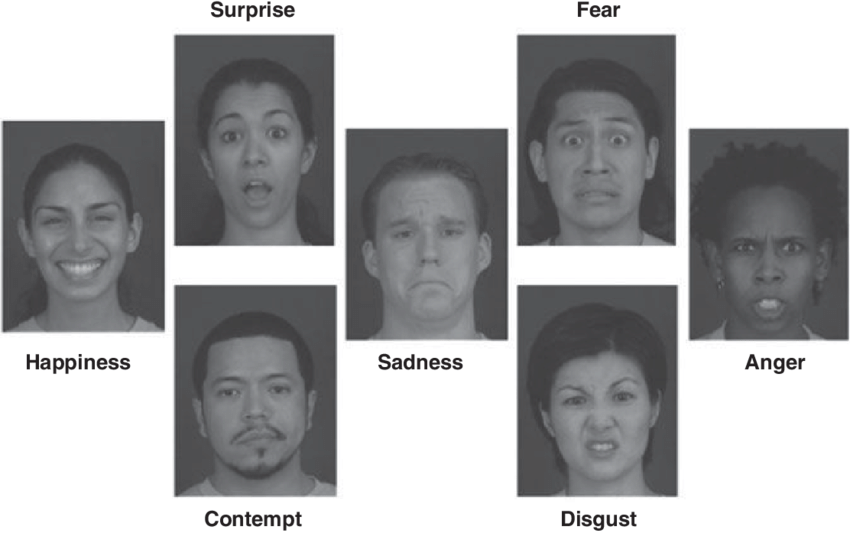Understanding Microexpressions
Microexpressions are brief, involuntary facial expressions that occur when a person is trying to conceal or repress an emotion. These fleeting expressions typically last between 1/25 to 1/15 of a second and reveal a person's true emotional state, making them invaluable tools for cold reading.
The Science of Microexpressions
Neurological Basis
Microexpressions originate from the limbic system—the brain's emotional command center. When we experience an emotion, the limbic system sends signals to the facial muscles before conscious awareness can intervene. This automatic response creates genuine expressions that are difficult to suppress.
Universal Emotions
Research by Dr. Paul Ekman has identified seven universal emotions that manifest in consistent facial expressions across all cultures:
- Happiness
- Sadness
- Fear
- Disgust
- Anger
- Surprise
- Contempt

Identifying Microexpressions
Happiness
- Corners of lips drawn up
- Cheeks raised
- Crow's feet wrinkles around eyes
- Lower eyelid may show wrinkles
Sadness
- Inner corners of eyebrows raised
- Corners of lips drawn downward
- Lower lip may be pouted
- Loss of focus in the eyes
Fear
- Eyebrows raised and drawn together
- Upper eyelids raised
- Lower eyelids tensed
- Lips stretched horizontally
- Jaw often dropped slightly
Disgust
- Upper lip raised
- Nose wrinkled
- Cheeks raised
- Eyebrows lowered
Anger
- Eyebrows lowered and drawn together
- Vertical lines between eyebrows
- Lower eyelids tensed
- Lips pressed firmly or open in square shape
- Dilated nostrils
Surprise
- Eyebrows raised high
- Eyes widened
- Jaw dropped, mouth open
- No tension in the face
Contempt
- One corner of the mouth raised
- Asymmetrical expression
- Often accompanied by a head tilt
Practical Detection Techniques
Training Your Eye
-
Start with Static Images
- Study photographs of emotional expressions
- Learn to identify facial muscle movements
- Practice with expression recognition software
-
Move to Dynamic Expressions
- Watch videos with muted sound
- Practice with speed recognition exercises
- Use training programs like METT (Micro Expression Training Tool)
-
Real-world Application
- Practice in low-stakes social situations
- Observe conversations without participating
- Create a mental log of expression patterns
Key Focus Areas
-
The Eyes
- Pupil dilation/constriction
- Blinking patterns
- Eye muscles (orbicularis oculi)
- Direction and duration of gaze
-
The Mouth
- Lip corners and center
- Tension in lips
- Asymmetrical movements
- Jaw position
-
The Forehead/Brow
- Vertical and horizontal furrows
- Eyebrow position
- Temple movement
- Asymmetrical patterns
Contextual Interpretation
Baseline Behavior
Establishing a person's baseline expression pattern is crucial for accurate interpretation:
- Observe natural resting face
- Note habitual expressions and tics
- Identify cultural and individual differences
- Consider medical conditions affecting facial muscles
Cluster Analysis
Individual microexpressions are most meaningful when observed in clusters:
- Look for congruence between multiple facial areas
- Track sequence of expressions
- Note incongruence between face and verbal message
- Identify mixed emotions (e.g., happiness with contempt)
Common Challenges
False Positives
-
Physical Factors
- Facial asymmetry
- Muscle twitches
- Lighting conditions
- Physical discomfort
-
Cultural Variations
- Display rules (cultural norms for expression)
- Context-specific expressions
- Gender differences in expression
Improving Accuracy
-
Verification Techniques
- Cross-reference with body language
- Listen for vocal tone changes
- Ask clarifying questions
- Track consistency over time
-
Continual Practice
- Regular training exercises
- Self-assessment and feedback
- Diverse subject practice
- Controlled environment testing
Ethical Applications
Professional Settings
- Negotiation dynamics
- Interview assessment
- Client relationship management
- Team communication evaluation
Personal Interactions
- Enhancing empathy
- Identifying emotional needs
- Improving personal connections
- Conflict resolution
Responsible Use
- Avoid making accusations based solely on microexpressions
- Consider alternative explanations
- Maintain privacy and respect
- Use insights constructively
Advanced Techniques
Microexpression Triggers
Understanding situations that commonly trigger microexpressions:
- Unexpected questions
- Personal topics
- Value conflicts
- Stress-inducing scenarios
Response Strategies
How to respond when you detect significant microexpressions:
- Adjusting conversation pace
- Changing topics strategically
- Creating psychological safety
- Addressing emotional states indirectly
Remember: Microexpression reading is a skill that requires continual practice and ethical application. The goal is deeper understanding, not manipulation or intrusion.